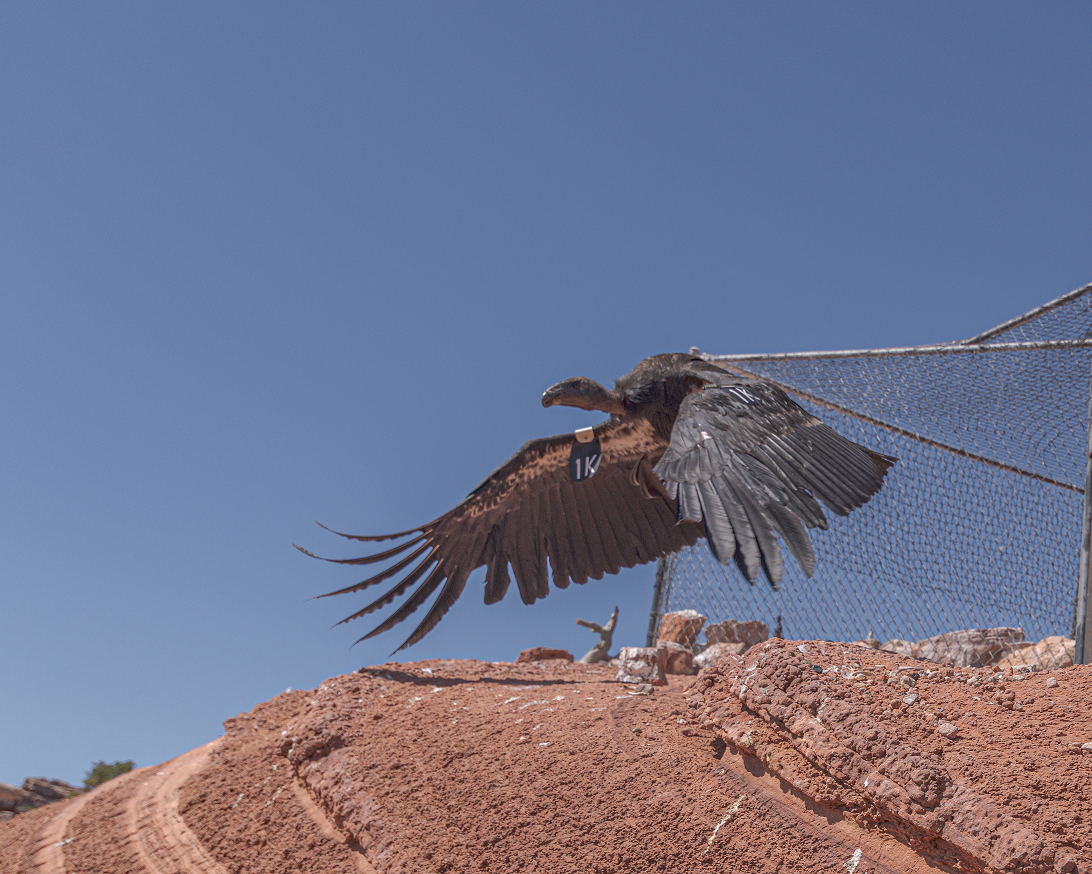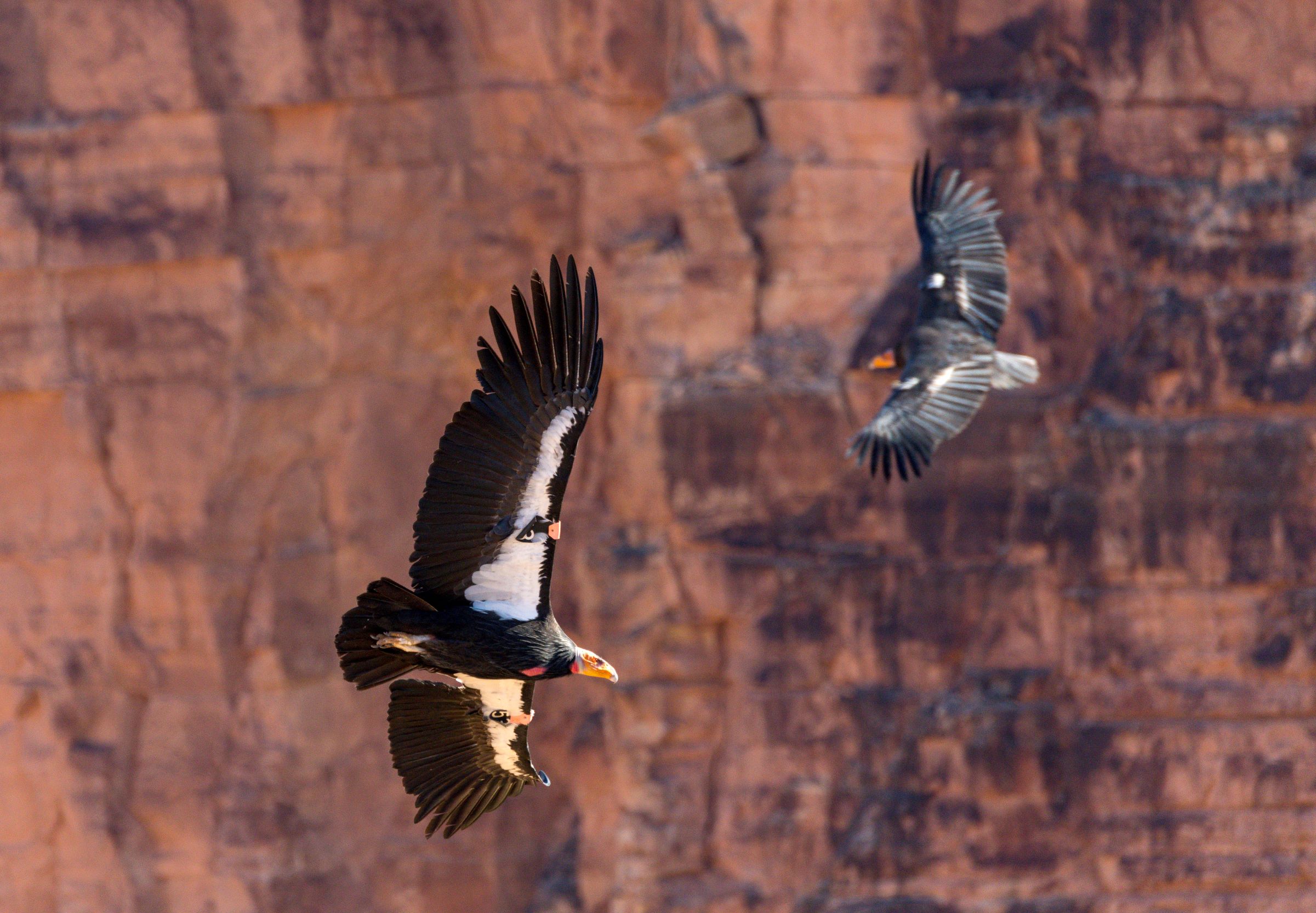Andrew Orr
26th Annual California Condor Release
Join us!
The Peregrine Fund and Bureau of Land Management at Vermilion Cliffs National Monument are hosting a celebration on National Public Lands Day, Saturday, September 25 at 12:30 p.m. MDT (11:30 MST, northern-Arizona Condor Time) by releasing captive-bred California Condors to take their first flights in the wild. The event will be held in-person at Vermilion Cliffs National Monument for anyone interested in travelling to the area, and it will also be live streamed via The Peregrine Fund’s YouTube Channel.
The Arizona-Utah California Condor conservation effort is a cooperative program by federal, state, and private partners, including The Peregrine Fund, the Bureau of Land Management’s Vermilion Cliffs National Monument, the Bureau of Land Management in Utah, Arizona Game and Fish Department, U.S. Fish and Wildlife Service, Grand Canyon and Zion National Parks, Utah Division of Wildlife Resources, and Kaibab and Dixie National Forests among many other supporting groups and individuals.
This is the 26th year the partnership has marked National Public Lands Day with a public release event at Vermilion Cliffs. In 2020, due to COVID-19 restrictions, the team took the celebration online with more than 10,000 viewers of the event. Because of that success, the event will be live streamed again this year in addition to the in-person event.
"The Bureau of Land Management is excited once again to host the annual Arizona/Utah California condor National Public Lands Day event at Vermilion Cliffs National Monument. The BLM, alongside other state and federal agencies are privileged to work together with The Peregrine Fund in the recovery of this great species. Last year, COVID-19 forced us to bring the event to the public virtually. We are excited to host the event in person, according to CDC guidelines, but also virtually so that the scope and reach of this incredible and successful collaborative effort can continue to reach all interested around the world," says Bureau of Land Management Vermilion Cliffs National Monument Manager, Brandon Boshell.
Condor Program Manager for The Peregrine Fund, Tim Hauck says, “We are unable to schedule exactly when the birds will choose to leave their release pen, so the live stream event will have a picture-in-picture set up with a camera trained on the release pen, and will include videos and interviews with the condor biologists and conservationists who work with these massive birds! Viewers will also be able to ask us questions and have them answered live by our team.”
Those who will be attending the event in person will have the opportunity to talk to condor biologists, learn about the birds and their habitat, and enjoy a festival-like atmosphere while waiting for the birds to take that first leap off of the cliff. Details about attending the event in person are below.
The young condors hatched at The Peregrine Fund’s World Center for Birds of Prey in Boise, Idaho and several partner organizations, including the Oregon Zoo, Los Angeles Zoo, and San Diego Zoo Safari Park and were transported to Vermilion Cliffs National Monument for release to the wild.
The historical California Condor population declined to just 22 individuals in the 1980s when the greater California Condor Recovery Program was initiated to save the species from extinction. A tremendously successful captive breeding program has allowed for reintroduction of the endangered birds back to the wild beginning first in 1992 in California and following in 1996 in Arizona. Lead poisoning is the primary cause of condor mortality and a remaining obstacle to the recovery of the population which has led to the formation of the North American Non-lead Partnership (NANP).
The Peregrine Fund’s Director of Global Conservation, Chris Parish describes how lead becomes a threat to condors and other birds of prey, “Free-flying condors are ingesting lead that they’re encountering on the landscape,” says Parish. “When scavenging birds and mammals eat the remains of carcasses shot with lead ammunition, tiny fragments of the heavy metal can be ingested and then absorbed into their bloodstream, often causing long-term side effects and sometimes even death.
Parish continues, “In response to this and on behalf of other wildlife, like Bald Eagles, Golden Eagles, and other birds of prey, exposed to preventable lead poisoning, we have partnered with the Oregon Zoo and the Institute for Wildlife Studies to form the North American Non-Lead Partnership.” The NANP seeks to expand the coalition of hunters, anglers, and other conservationists dedicated to improving ecosystem and wildlife health by choosing to use non-lead alternatives.
Non-lead ammunition options, such as high performance solid copper bullets, help prevent lead poisoning in scavengers. “Voluntary lead-reduction programs in Arizona and Utah have been very successful,” said Parish. “We are excited about the growth of the partnership and want to see these voluntary efforts continue to expand across North America. Sportsmen and -women have been at the forefront of natural resource conservation throughout North America for over a century, and hunters have successfully met numerous conservation challenges in the past. We are confident that as the partnership grows, more hunters and organizations will join.”
As of July 2021 there are more than 100 condors in the wild in the rugged canyon country of northern Arizona and southern Utah and the total world population of endangered California Condors numbers more than 500 individuals, with more than half flying the skies of Arizona, Utah, California, and Mexico.
Information about attending the event in person:
Driving directions: Take Highway 89A from Kanab or Page to the Vermilion Cliffs (from Flagstaff take Highway 89 to Highway 89A). Turn north onto BLM Road 1065 (a dirt road next to the small house just east of the Kaibab Plateau) and continue almost 3 miles.
Bring: Spotting scope or binoculars, sunscreen, water, snack, chair, and layered clothing
Details: Informational kiosk, shade structure, and restroom at the site. The event will follow the CDC guidelines in place for outdoor gatherings at the time of the event.
Map: https://on.doi.gov/3dW2f4m
Learn more:
- Learn more about our California Condor recovery project.
- Learn more about the North American Non-lead Partnership.
- Watch a segment on CBS This Morning featuring our California Condor and North American Non-lead Partnership projects!
This year we are planning to hold the annual release live at the Vermilion Cliffs National Monument in Arizona as well as virtually online and we hope you will join us! Mark your calendars today and check back here for more details soon.









